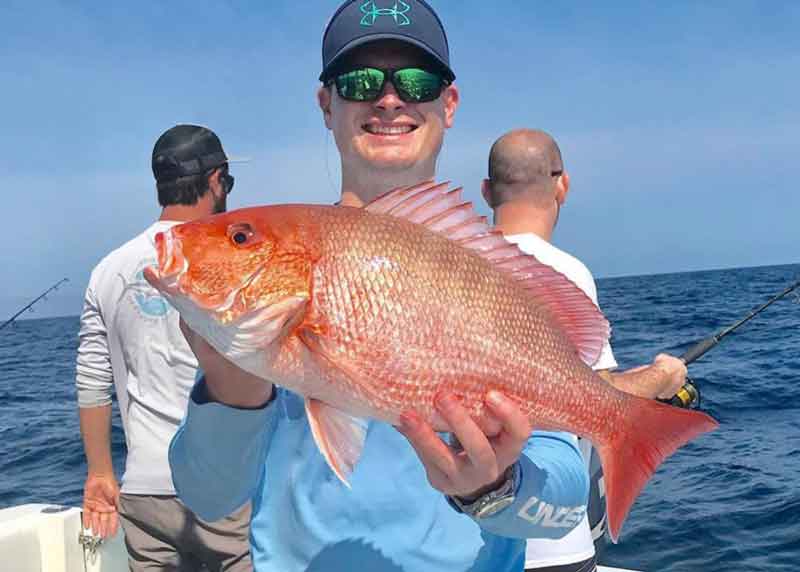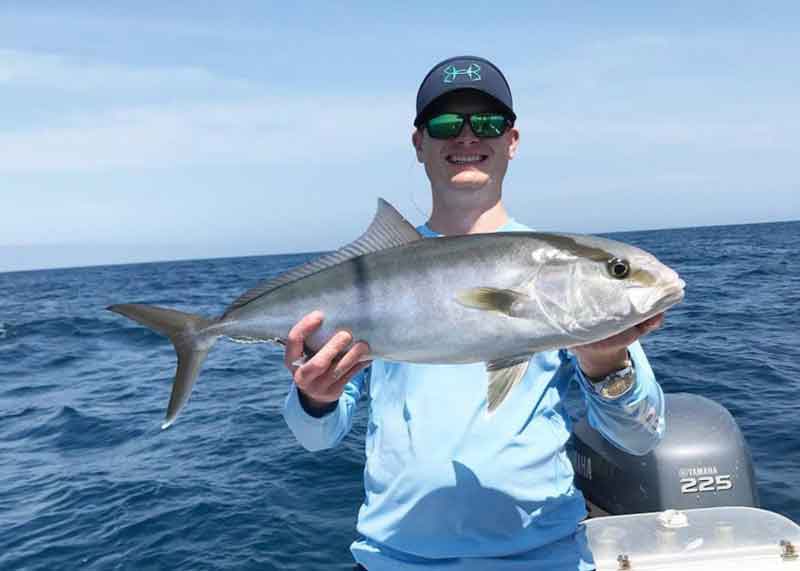Madeira Beach, Florida: Five slightly hungover, Uber-challenged bachelor-party fishermen are showing up for their fishing charter 45 minutes late. Young Captain Kellen had no issues with this; he’s seen it before. The motley crew jumps on to his 32 Contender and heads out of the inlet while discussing tactics (and headache remedies) for the day. The Captain recommends fishing the red-hot kingfish bite, which is about 10 miles away. We ask him about other options because we want to do some light-tackle wreck fishing as opposed to trolling, and he lets us know we could also go for blackfin and skippy tuna about 20 miles away, or we can make a 44-mile run to 88 feet of water and catch snapper, amberjack, grouper, and other bottom fish. The crew briefly discusses the options and after about 30 seconds we decide to make the long 44 mile run to tie into what we really want.

Captain Kellen tosses his cast net at the bridge at John’s Pass and loads up the boat with sardines and other baitfish before we make the run through choppy waters. Kellen watches the fishfinder as we go, marking any structure that jumps up so he can return later to check it out.
After about 90 minutes we arrive at the location marked on the GPS, which he tells us he found himself. It’s not on any of the fishing charts. We glance at the screen and the fishfinder is lit up from top to bottom. The Captain tells us to look over the side of the boat. Curious fish are everywhere, coming straight up to the boat to see what the noise is. We grab rods and are itching to get a bait in the water as fast as possible. This isn’t something we see often in our hometown Chesapeake Bay waters. The Captain calmly says, “they’re still going to be here, let me get the anchor set,” and takes his time aligning us perfectly over what he believes to be an old shrimp boat.
Once anchored, we all grab sardines from the livewell and bait our hooks. Within seconds we’re live-lining sardines over the side, bail open, and drifting baits back after a quick toss away from the boat. We watch the fish in the water as they notice the bait, close the bails, and watch anxiously as the bait tries to swim away. Action couldn’t have been more immediate. The fish hone in and attack with aggressive strike, and our first fish is hooked up within 30 seconds! The line goes tight and drag starts screaming on the 4500 Spinfisher, as the rod buckles over.
The fights are incredible as we start pulling in sizable red snapper and amberjack. The crew starts rotating around the boat, catching different species out of each corner. In the stern corners, two guys are working the top of the water column catching mutton snapper. On the front of the boat two guys are dropping as far down as they can get… but never making it to bottom. They’re coming up with amberjack, grouper, red snapper, and triggerfish. The fifth fisherman is rotating around and filling the spot of whoever is boating a fish. Questionable efficiency at best, but all filled with laughter. The crew can’t be happier as the non-stop action ensues for about the next four hours before slowing down.

With the bite turning finicky we start sizing down the leaders, which results in a few more bites with a much higher breakoff percentage. Catching 25-pound amberjack on 20-pound leader was proving difficult. The guys on the front are finally making it to bottom now. However, while trying to reel up their fish goliath groupers are engulfing whatever they have on. The rods bend hard over and then snap back up with the line going slack, as the leader is broken off. We try live-living some bigger baits on a goliath grouper rig but can’t get the fish to swim out of the wreck without chaffing and breaking the leader.
Eventually we pull anchor and head about two miles to our next destination. The Captain anchors and tells us the mutton are going to come up first. We’ll only have a quick shot at them before the triggerfish and other species come in and scare them off. Everyone gets ready and puts their lines in the water. Sure enough, we get several mutton snappers right off the bat. Then the other species show up and push the mutton away from the boat. The bite is solid for about an hour, though nothing like earlier in the day. We end up catching some great fish at this location and the captain knows we’re having a great time, so he extends our time a little until the bite slows. We were fortunate that the wind was dying down, which made for a nice cruise back while the crew enjoyed some cold ones and recalled the incredible fishing we’d just experienced.
The next day all nine of us on the bachelor party enjoyed the fish grilled, jerked, and fried at Sea Critters Café on the water in Saint Pete Beach. While the rest of the weekend may be blurry and filled with instances we don’t need to talk about, Howard’s bachelor party was off to a great start.
If you find yourself heading to the Gulf Coast of Florida, a trip with Captain Kellen out of Madeira Beach is well worth it; check him out!
Tips For Travel Fishing
- Pack a cooler so you can bring some fillets back home. A small lightweight one works great for airplanes. I generally will carry on or check an RTIC 15 which costs $31.99 and keeps items cold for up to 24 hours. A larger one works great but is not always easy to bring along. Soft coolers can be collapsed and packed into your carry-on for the flight down, then stuffed and checked for the flight home.
- Plan ahead for rides if you don’t have a car. We learned this lesson the hard way. We should have lined up a cab at an exact time and location as we had multiple cancellations from both Uber and Lyft. Don’t rely on them to be prompt at five in the morning.
- Discuss fishing tactics with your captain both when you book and when you arrive at the dock. For example, if you have the option and would rather do light tackle than trolling, or vice versa, then let them know your thoughts on the matter. However, also consider their recommendations. The captain knows what will bring the most fish over the side of the boat, but will also take your desires into consideration.
Florida Options
Anglers most interested in pelagics should look for guides along the East coast. Winter hotspots for sailfish, wahoo, blackfin, and mahi can range from Jacksonville clear down to Key West. The Gulf coast has a great inshore bite for species like specks, reds, and snook much of the year, as well as wreck fishing and in some areas blackfin tuna fishing, though runs can be long since the Gulf side has a very gradual drop-off in most areas. They Keys often provides the best of both worlds, as you can run to either the Atlantic or the Gulf – or fish the flats and mangroves in-between. Many areas in the Keys also have the added advantage of fewer cancellations due to wind, since you can choose to run either east or west to fish in the lee.